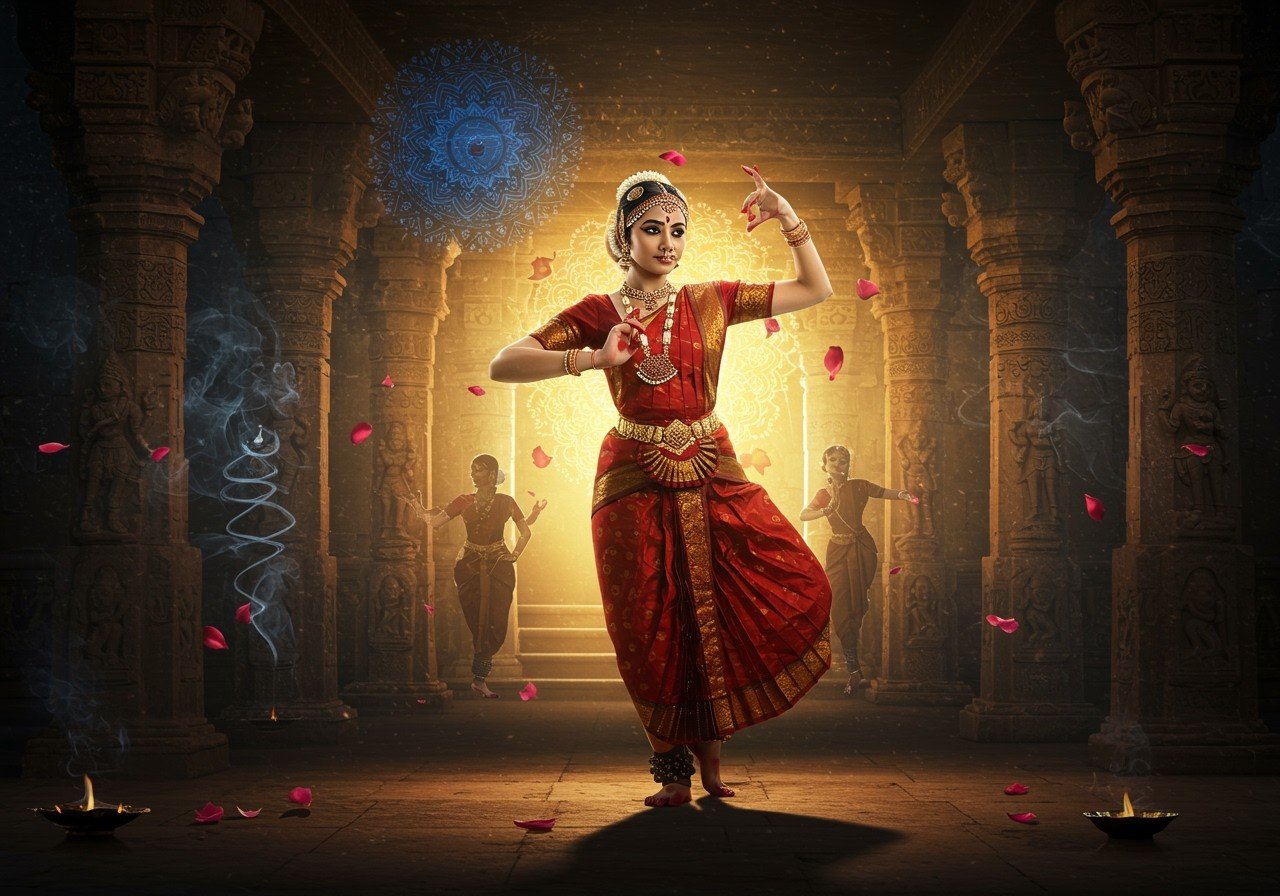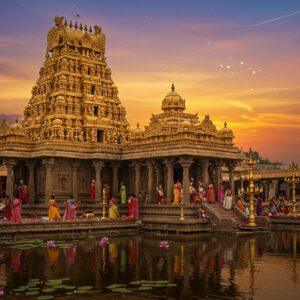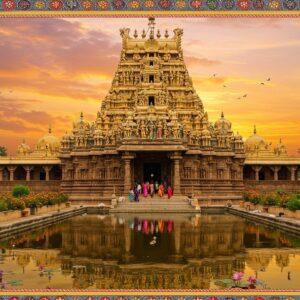
Temple dance, a sacred art form deeply rooted in Indian culture, has for centuries served as a powerful medium for expressing spirituality and devotion through movement. It holds immense historical significance within Indian classical traditions, particularly in South India where it originated as a form of worship, fostering a profound connection with the divine and preserving India’s rich cultural heritage.
Understanding the Essence of Temple Dance
Temple dance, in its purest form, is a classical art form traditionally performed in Hindu temples to honor deities. Its origins trace back to ancient India, where it was an integral part of religious rituals and ceremonies. Over time, various styles of temple dance emerged, each with its own distinct characteristics and regional influences, such as Bharatanatyam, Odissi, and Kuchipudi. These dances showcase the diversity and richness of India’s cultural landscape.
- Bharatanatyam: Originating from Tamil Nadu, this dance form is renowned for its elegance, grace, and precise, sculpturesque poses that convey deep spiritual meaning.
- Odissi: Hailing from Odisha, Odissi is characterized by its lyrical movements and fluid storytelling, often drawing inspiration from temple sculptures and ancient scriptures. It is believed to be one of the oldest surviving Indian classical dance forms.
- Kuchipudi: This vibrant dance form, originating from Andhra Pradesh, seamlessly blends dance and drama, captivating audiences with its expressive storytelling and dynamic movements.
The key elements of temple dance include intricate movements, expressive gestures (mudras), and elaborate costumes that add to the visual spectacle. Mudras, symbolic hand gestures, and abhinaya, the art of expressive storytelling, play a crucial role in conveying spiritual messages and narratives. Music and rhythm are also integral, enhancing the divine experience and creating an atmosphere of reverence.
Dancers undergo rigorous spiritual preparation and disciplined training to embody the divine during performances, making temple dance not just an art form but a spiritual practice.
The Devadasi Tradition: A Legacy of Devotion
In ancient India, the Devadasi tradition held a prominent place in the world of Temple Dance. Women known as Devadasis dedicated their lives to serving deities through dance and music, embodying a deep connection between spirituality and artistic expression. These women were highly respected within temple communities and played a crucial role in preserving cultural and spiritual knowledge.
The training of Devadasis commenced at a young age, immersing them in the intricacies of classical dance and music while nurturing a life of devotion. Their dedication was formally recognized in a special ceremony known as ‘Pottu Kattu,’ signifying their lifelong commitment to the divine.
Unfortunately, during the British colonial era, the Devadasi tradition encountered significant challenges and experienced a period of decline, impacting the practice of Temple Dance. However, thanks to the unwavering efforts of dedicated artists, the 20th century witnessed a revival of this sacred art form. Temple dance was adapted for stage performances, ensuring its preservation for future generations and expanding its reach beyond the temple walls.
Notable figures like Balasaraswati and Rukmini Devi Arundale played pivotal roles in revitalizing and preserving the tradition, leaving an indelible mark on modern Indian classical dance.
A Kaleidoscope of Temple Dance Styles Across India
India’s temple dance traditions are as diverse as the nation itself, with each region boasting its own unique styles, costumes, and musical traditions. Let’s explore some of the prominent forms:
- Bharatanatyam (Tamil Nadu): Characterized by its grace, purity, and sculpturesque poses, Bharatanatyam captivates audiences with its intricate footwork, expressive eye movements, and powerful storytelling.
- Odissi (Odisha): Considered the oldest surviving dance form in India, Odissi’s lyrical movements and flowing gestures are inspired by the sculptures adorning ancient temples. Its captivating performances bring stories from mythology and scripture to life.
- Kuchipudi (Andhra Pradesh & Telangana): This dance form seamlessly integrates dance and drama, featuring both singing and dancing by the performers. Kuchipudi’s vibrant storytelling and expressive abhinaya create a mesmerizing experience for the audience.
- Kathakali (Kerala): A highly stylized theatrical dance-drama, Kathakali is renowned for its elaborate costumes, intricate makeup, and powerful portrayal of characters from Hindu epics. Traditionally performed by men, it combines athleticism, grace, and dramatic storytelling.
- Mohiniyattam (Kerala): Known for its graceful and feminine movements, Mohiniyattam enchants with its fluidity and expressive storytelling, often depicting tales of love and devotion.
- Sattriya (Assam): Performed in Vaishnavite monasteries, Sattriya incorporates religious themes and devotional narratives into its dance-drama performances.
These diverse forms, each with its own distinct regional flavor, contribute to the rich tapestry of Indian Temple Dance, showcasing the country’s vibrant cultural heritage.
The Spiritual Heart of Temple Dance
Temple dance is more than just an artistic expression; it is a powerful medium for spiritual exploration and devotion. Rooted in Hindu spiritual concepts of bhakti (devotion) and moksha (liberation), it transcends the physical realm and connects the dancer to the divine. Through rhythmic movements and expressive gestures, dancers strive to achieve a state of spiritual ecstasy, finding inner peace and fulfillment. The audience, too, is invited to partake in this spiritual journey, experiencing the divine connection through the dancer’s performance.
Even in contemporary times, temple dance continues to hold deep relevance in spiritual practices and festivals, inspiring reverence and devotion among audiences worldwide.
Poojn.in: Supporting Your Temple Dance Journey
Creating the right spiritual ambiance for temple dance often requires specific items and offerings. At Poojn.in, we offer a wide selection of authentic puja items designed to enhance your temple dance practice and deepen your devotional experience. Our offerings include:
- Pure Brass Bells and Ghungroos: Enhance your rhythmic expressions with our collection of pure brass bells and ghungroos, known for their clear, resonant sounds. Browse our selection here.
- Traditional Dance Accessories: Discover authentic and beautifully crafted dance accessories made from traditional materials to complement your attire and enhance your performance. Find what you need here.
- Dance Practice Wear: We offer comfortable and elegant cotton and silk dance practice wear in various sizes to enhance your comfort and grace during practice. Find your perfect fit here.
- Specialized Floor Mats: Practice with ease and stability on our specialized floor mats, providing a supportive surface for your temple dance routines. Explore our options here.
- Pure Copper Water Vessels: Elevate your rituals with our pure copper water vessels, ideal for ritual cleansing and maintaining the sanctity of your practice. Discover our collection.
- Natural Incense and Dhoop: Create a sacred and serene atmosphere with our selection of natural incense and dhoop, enriching your devotional experience. Enhance your ambiance here.
We offer convenient home delivery across India, ensuring that your chosen items arrive with quality assurance and proper packaging to maintain their purity. For personalized guidance on selecting the right items for your temple dance needs, you can:
- Call us at 03369029784
- Message us on WhatsApp at 9476142738
- Visit our website at poojn.in
Each product on our website comes with detailed descriptions and instructions for proper usage. We ensure all items meet traditional specifications, combined with the ease and convenience of online shopping and home delivery. Let Poojn.in, India’s largest Dashakarma bhandar, help you create an authentic and inspiring temple dance environment in your own space.
Embracing the Timeless Legacy of Temple Dance
Temple dance is a profound expression of devotion, culture, and tradition. It holds a cherished place in the hearts of many, celebrating a rich heritage passed down through generations. Today, this sacred art form thrives not only in temples but also on stages worldwide, captivating audiences with its timeless grace, spiritual depth, and captivating storytelling.
As we honor this legacy, we embrace the stories and traditions it embodies. Each step, gesture, and rhythm serves as a reminder of the divine connection fostered through temple dance, inviting us to embark on our own spiritual journey with reverence and joy. For those seeking to enrich their lives with cultural and spiritual experiences, temple dance offers a path filled with beauty, meaning, and profound connection.
Frequently Asked Questions about Temple Dance
What is temple dance? Temple dance is a traditional and sacred dance form performed in Hindu temples as a form of worship and devotion to deities.
What is the Devadasi tradition’s connection to temple dance? Devadasis were women traditionally dedicated to serving the temple deity through dance. They played a significant role in preserving and performing temple dance traditions.
How did temple dance originate in India? Temple dance has ancient roots in India, originating as a form of worship and ritualistic expression. It evolved over centuries, influenced by various cultural and religious traditions.
What are some renowned forms of temple dance? Prominent temple dance forms include Bharatanatyam, Odissi, Kuchipudi, Kathakali, Mohiniyattam, and Sattriya, each with its unique style and regional influences.
Why is temple dance significant in Indian culture? Temple dance plays a vital role in preserving ancient traditions, connecting people to their spiritual heritage, and expressing cultural narratives through movement and music. It has also had an influence on some of the more contemporary dance forms.
How is temple dance practiced today? Temple dance continues to be performed in traditional religious settings and has also found a place on stage as a classical art form, captivating audiences worldwide.
Is learning temple dance accessible to everyone? Yes, anyone with dedication and a passion for the art can learn temple dance. It requires practice and discipline to master the intricate movements and expressive elements.
What role does music play in temple dance? Music is an integral part of temple dance, providing rhythm, enhancing emotional expression, and creating the ambiance for the performance. Traditional instruments like the mridangam and veena often accompany the dance.


